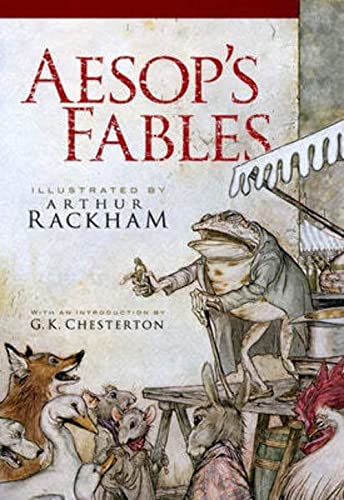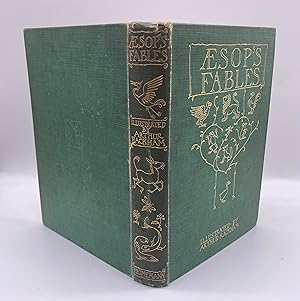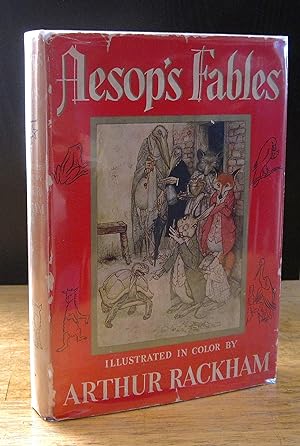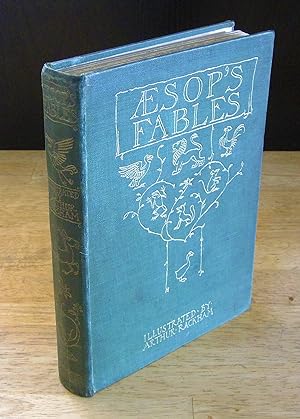V S Vernon Jones Introduction G K (17 results)
FeedbackSearch filters
Product Type
- All Product Types
- Books (17)
- Magazines & Periodicals (No further results match this refinement)
- Comics (No further results match this refinement)
- Sheet Music (No further results match this refinement)
- Art, Prints & Posters (No further results match this refinement)
- Photographs (No further results match this refinement)
- Maps (No further results match this refinement)
- Manuscripts & Paper Collectibles (No further results match this refinement)
Condition
Binding
Collectible Attributes
- First Edition (7)
- Signed (No further results match this refinement)
- Dust Jacket (2)
- Seller-Supplied Images (7)
- Not Print on Demand (17)
Language (2)
Free Shipping
Seller Location
Seller Rating
-
Hardcover. Condition: Good. Arthur Rackham (illustrator).
More buying choices from other sellers on AbeBooks
New offers from £ 90.09
Used offers from £ 9.20
Also find Hardcover
-
Paperback. Condition: Brand New. Rackham, Arthur (illustrator). reprint edition. 223 pages. 8.00x5.50x0.75 inches. In Stock.
-
Hardcover. Condition: Brand New. 142 pages. 6.00x0.38x9.00 inches. In Stock.
-
Aesop's Fables
Published by William Heinemann, 1933
Seller: Buckle's Books, Cambridge, United Kingdom
Hardcover. Condition: Good. Arthur Rackham. (illustrator). Cheaper edition hardback, red cloth covereed boards with black line illustration to front and spine. Spine is faded. Previous owners name to endpapers. Frontis is loose but present. Front hinge is cracked after first free endpaper. Slight foxing to page edges. Good condition.
-
Aesop's Fables First US Rackham illustrated edition 13 color plates 53 b/w illustrations fine.
Published by London: William Heinemann (and) New York: Doubleday, Page and Co.,, 1912
Language: English
Seller: J & J House Booksellers, ABAA, Kennett Square, PA, U.S.A.
First Edition
£ 342.80
Convert currency£ 48.07 shipping from U.S.A. to United KingdomQuantity: 1 available
Add to basketHardcover. Condition: Fine. 1st Edition, Illustrated Edition. First US Rackham illustrated edition, 8vo (8.25 x 6 inches), pp. xxix, (1), 1-223, (1), 13 color plates with printed guards and 53 b/w illustrations many full page after paintings and drawings by Arthur Rackham. Original black lettered gray cloth with color plate on upper side. Unusually fine clean bright condition. Sheets and plates fine, clean, unmarked, complete. No owner names or inscriptions. H11005 All Items Are Sent Insured. Insurance charges are included in the Shipping & Handling Charges. International buyers please be aware that we are not responsible for and do not include or estimate customs duties, fees or taxes in any way in our listings. We ship all orders within 2 to 5 days of cleared payment. The estimated shipping times and estimated arrival dates given in the listing are not provided by us and are usually wrong or very misleading. We do not pay for any foreign taxes or customs duties and have no information about them. These are the responsibility of the buyer. We do not create and are not responsible for shipping times or delays associated with customs and international shipping.
-
Aesop's Fables. A New Translation
Published by William Heinemann. London, 1931
Seller: Cotswolds Rare Books, OXFORDSHIRE, United Kingdom
Hardcover. Condition: Very Good. Small po bookplate to inside cover, otherwise a very clean, bright copy.
-
Aesop's Fables. A New Translation by V. S. Vernon Jones. With an Introduction by G. K. Chesterton. Illustrated by Arthur Rackham. FIRST EDITION.
Published by William Heinemann. London, 1912
Seller: Addyman Books, Hay-on-Wye, United Kingdom
First Edition
William Heinemann. 1912. First edition. Hardback, no DW. Original green cloth, decorated in gilt. Spine knocked with light vertical crease, extremities rubbed, head and tail of spine frayed, lower joint partially split along bottom quarter but sound. 13 coloured plates plus numerous b/w illustrations in text. Inner hinges partially visible and contents very slightly shaken. Prize bookplate to front endpaper, endpapers browned, occasional light foxing otherwise a clean copy.
-
Aesop's Fables
Published by William Heinemann, 1912
Seller: Love Rare Books, St Leonards On Sea, East Sussex, United Kingdom
First Edition
Hardcover. Condition: Very Good. 1st Edition. Octavo. 210mm x 160mm. 224 pp. Green cloth with elaborate gilt stylings to front panel and spine. Touches of rubbing/edge wear, scuffing to corners but a handsome copy. Minor spotting to the first and last few pages with very occasional spotting to margins within. Tidy gift inscription dated 1912 to endpaper. The book is now in a protective removable acetate cover. 13 full-page, tissue-guarded colour illustrations by Rackham, one of the giants of the Golden Age of illustrated books.
-
Aesop's Fables: A New Translation Illustrated in Colour and Black & White by Arthur Rackham
Published by Garden City Publishing Co., New York, 1939
Seller: The BiblioFile, Rapid River, MI, U.S.A.
First Edition
£ 178.22
Convert currency£ 50.25 shipping from U.S.A. to United KingdomQuantity: 1 available
Add to basketHard Cover. Condition: Very Good. Dust Jacket Condition: Good. Rackham, Arthur (illustrator). First Edition. 1939 at copyright; early printing in rare pictorial wrapper. Superbly illustrated, decorated, and featuring a thoroughly enjoyable introduction by G. K. Chesterton. Red full-cloth boards, Rackham mounted color plate, gilt spine titles, moderate shelf wear, spine rub. Front boards features color plate of The Hare and the Tortoise surrounded with blind-stamped animals: lion, wolf, stork, crow, rooster, frog, and owl. Deckled pages near fine, clean; no writing. Small antiquarian label inside cover: "Sally Stilson, Madison Heights, Anderson, Indiana". With thirteen richly colored, smooth coated plates by Arthur Rackham and over fifty black and white illustrations, many full-page, in immaculate detail throughout. Bind good; hinges intact. Rare pictorial wrapper moderate edge, spine sunning, discoloration; protected in new clear sleeve. Front panel in deep red w/stylized titles, Rackham's hare and fox illustration; back panel features illustrated classics of the time availabe from Garden City books. Near fine profusely illustrated book of classic moral fables in good original wrapper. Aesop's Fables was first published in 1912 with this imagery by Rackham. Includes two-hundred fables of timeless humor and wisdom. "In Aesop's Fables (1912) Rackham's primary intention was to amuse, but his illustrations for fables of 'The Moon and her Mother' and 'The Gnat and the Lion' suggest the imaginative refinement that he brought to the task. Rackham was often his own model; there are several self-caricatures to be detected in Aesop's Fables. He is the man who catches the flea, the pompous gentleman who scolds the drowning boy, the credulous slave-owner who scrubs the black boy" (Hudson, Derek. Arthur Rackham His Life and Work, p. 94). Aesop's Fables or the Aesopica is a collection of fables credited to Aesop, a slave and story-teller believed to have lived in ancient Greece between 620 and 560 B.C. The first century A.D. philosopher, Apollonius of Tyana, is recorded as having said about Aesop: ". like those who dine well off the plainest dishes, he made use of humble incidents to teach great truths, and after serving up a story he adds to it the advice to do a thing or not to do it. Then, too, he was really more attached to truth than the poets are; for the latter do violence to their own stories in order to make them probable; but he by announcing a story which everyone knows not to be true, told the truth by the very fact that he did not claim to be relating real events" (Philostratus, Life of Apollonius of Tyana, Book V:14).Latimore and Haskell pp. 38-39. Printed in the United States of America. 224 pages. Insured post. Size: 8vo - over 7¾ - 9¾" Tall.
-
Aesop's Fables: A New Translation Illustrated in Colour and Black & White By Arthur Rackham
Published by William Heinemann, London, 1956
Seller: The BiblioFile, Rapid River, MI, U.S.A.
First Edition
£ 224.72
Convert currency£ 50.25 shipping from U.S.A. to United KingdomQuantity: 1 available
Add to basketHard Cover. Condition: Very Good. Dust Jacket Condition: Very Good. Rackham, Arthur (illustrator). First Edition. First printed in 1912; stated 1956 printing, the twelfth, in scarce pictorial wrapper. Superbly illustrated, decorated, and featuring a thoroughly enjoyable introduction by G. K. Chesterton. Evergreen full-cloth boards, bright silver cover vignette and spine titles, moderate shelf, corner wear. Bright silver flying stork vignette at spine. Pages generally very good, clean; no writing. Light fox to exterior text block. Small yellow striped antiquarian label inside cover: "Harold Hockey Ltd. Stationers & Booksellers, Clifton, Bristol 8." Illustrated endpapers featuring: an eagle, lion, rooster, frog, fox, mouse and duck; toned areas from removed adhesive at front and back endpaper. With eight richly colored, smooth coated plates by Arthur Rackham and over fifty black and white illustrations, many full-page, in immaculate detail throughout. Bind good, square; hinges intact. Original white pictorial dust wrapper, moderate rub, discoloration, small spine sticker-pull; unclipped 15s NET, protected in new clear sleeve. Front panel features Rackham's "The Blackamoor" plate, as the first edition, w/title at spine; advert for Rackham titles from Heinemann at back panel. Attractive near very good mid-century printing in rare near fine wrapper. Aesop's Fables was first published in 1912 with this imagery by Rackham. Includes two-hundred fables of timeless humor and wisdom. "In Aesop's Fables (1912) Rackham's primary intention was to amuse, but his illustrations for fables of 'The Moon and her Mother' and 'The Gnat and the Lion' suggest the imaginative refinement that he brought to the task. Rackham was often his own model; there are several self-caricatures to be detected in Aesop's Fables. He is the man who catches the flea, the pompous gentleman who scolds the drowning boy, the credulous slave-owner who scrubs the black boy" (Hudson, Derek. Arthur Rackham His Life and Work, p. 94). Aesop's Fables or the Aesopica is a collection of fables credited to Aesop, a slave and story-teller believed to have lived in ancient Greece between 620 and 560 B.C. The first century A.D. philosopher, Apollonius of Tyana, is recorded as having said about Aesop: ". like those who dine well off the plainest dishes, he made use of humble incidents to teach great truths, and after serving up a story he adds to it the advice to do a thing or not to do it. Then, too, he was really more attached to truth than the poets are; for the latter do violence to their own stories in order to make them probable; but he by announcing a story which everyone knows not to be true, told the truth by the very fact that he did not claim to be relating real events" (Philostratus, Life of Apollonius of Tyana, Book V:14).Latimore and Haskell pp. 38-39. Printed in Great Britain at The Windmill Press, Kingswood, Surrey. 5 1/4" x 8" design. 224 pages. Insured post. Size: 8vo - over 7¾ - 9¾" Tall.
-
Aesop's Fables: A New Translation Illustrated in Colour and Black & White By Arthur Rackham
Published by William Heinemann, Limited - Doubleday, Page & Co., London - New York, 1912
Seller: The BiblioFile, Rapid River, MI, U.S.A.
First Edition
£ 300.90
Convert currency£ 50.25 shipping from U.S.A. to United KingdomQuantity: 1 available
Add to basketHard Cover. Condition: Good. Rackham, Arthur (illustrator). First Edition. 1912 at title page; "Printed in England" at copyright page. Olive green full cloth boards, black cover and spine titles, Rackham pictorial plate of "The Quack Frog" at cover, some corner, edge wear, spine rub; back board worn along exterior edge. Pages generally very good; moderate discoloration, some toning. Includes frontipiece plate with captioned tissue guard: "The Hare and the Tortoise". Pictorial endpapers of collage line-drawing of Aesop's animal characters. Small antiquarian signature at front pastedown. Bind good, moderate cant; hinges intact. Superbly illustrated, decorated, and featuring a thoroughly enjoyable introduction by G. K. Chesterton. With a dozen richly colored, smooth coated plates by Arthur Rackham and over fifty black and white illustrations, many full-page, in immaculate detail throughout. Near good first edition thus of this illustrated rarity from 1912. Printed by Ballantyne & Company Ltd. at the Ballantyne Press, Tavistock Street, Covent Garden, London. 224 pages. Insured post. Aesop's Fables was first published in 1912 with this imagery by Rackham. Includes two-hundred fables of timeless humor and wisdom. "In Aesop's Fables Rackham's primary intention was to amuse, but his illustrations for fables of 'The Moon and her Mother' and 'The Gnat and the Lion' suggest the imaginative refinement that he brought to the task. Rackham was often his own model; there are several self-caricatures to be detected in Aesop's Fables. He is the man who catches the flea, the pompous gentleman who scolds the drowning boy, the credulous slave-owner who scrubs the black boy" (from Derek Hudson, Arthur Rackham His Life and Work). Aesop's Fables or the Aesopica is a collection of fables credited to Aesop, a slave and story-teller believed to have lived in ancient Greece between 620 and 560 B.C. The first century A.D. philosopher, Apollonius of Tyana, is recorded as having said about Aesop: "Like those who dine well off the plainest dishes, he made use of humble incidents to teach great truths, and after serving up a story he adds to it the advice to do a thing or not to do it. Then, too, he was really more attached to truth than the poets are; for the latter do violence to their own stories in order to make them probable; but he by announcing a story which everyone knows not to be true, told the truth by the very fact that he did not claim to be relating real events" (Philostratus, Life of Apollonius of Tyana, Book V). Size: 8vo - over 7¾ - 9¾" Tall.
-
Aesop's Fables: A New Translation Illustrated in Colour and Black & White by Arthur Rackham
Published by William Heinemann - Doubleday, Page & Co., London - New York, 1912
Seller: The BiblioFile, Rapid River, MI, U.S.A.
First Edition
£ 377.08
Convert currency£ 50.25 shipping from U.S.A. to United KingdomQuantity: 1 available
Add to basketHard Cover. Condition: Good. Rackham, Arthur (illustrator). First Edition. 1912 at title page. Copyright page states "All Rights Reserved"; no other dates, indications. Olive green full cloth boards, gilt cover and spine design and titles,moderate cover, edge wear, rub. Front cover features stylized gilt titles and various animal characters and decoration. Spine features additional animals and titles in gilt. Back board feature blind-stamped Heinemann windmill emblem. Pages generally very good; moderate toning. Includes frontispiece plate with captioned tissue guard: "The Hare and the Tortoise." Mended closed tear to the "The Quack Frog," adjacent page 56. White pictorial endpapers repeat cover motif of animals in green outline. Dark green top-stain. Bind good, square; hinges intact. Superbly illustrated, decorated, and featuring a thoroughly enjoyable introduction by G. K. Chesterton. With thirteen richly colored, smooth coated plates by Arthur Rackham and over fifty black and white illustrations, many full-page, in immaculate detail throughout. Near very good first edition thus. Printed by Ballantyne & Company Ltd. at the Ballantyne Press, Tavistock Street, Covent Garden, London. 224 pages. Insured post. Aesop's Fables was first published in 1912 with this imagery by Rackham. Includes two-hundred fables of timeless humor and wisdom. "In Aesop's Fables Rackham's primary intention was to amuse, but his illustrations for fables of 'The Moon and her Mother' and 'The Gnat and the Lion' suggest the imaginative refinement that he brought to the task. Rackham was often his own model; there are several self-caricatures to be detected in Aesop's Fables. He is the man who catches the flea, the pompous gentleman who scolds the drowning boy, the credulous slave-owner who scrubs the black boy" (from Derek Hudson, Arthur Rackham His Life and Work). Aesop's Fables or the Aesopica is a collection of fables credited to Aesop, a slave and story-teller believed to have lived in ancient Greece between 620 and 560 B.C. The first century A.D. philosopher, Apollonius of Tyana, is recorded as having said about Aesop: "Like those who dine well off the plainest dishes, he made use of humble incidents to teach great truths, and after serving up a story he adds to it the advice to do a thing or not to do it. Then, too, he was really more attached to truth than the poets are; for the latter do violence to their own stories in order to make them probable; but he by announcing a story which everyone knows not to be true, told the truth by the very fact that he did not claim to be relating real events" (Philostratus, Life of Apollonius of Tyana, Book V). Size: 8vo - over 7¾ - 9¾" Tall.












